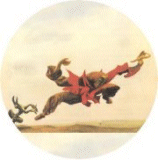
Contents ||| Study Tools |||
Classical Literature ||| Contact |||
Blog
What is beauty, what is art?
James Joyce: A portrait of the artist as a young man
Excerpts from Joyce's novel
Page 8
-To finish what I was saying about beauty, said Stephen, the most satisfying relations of the sensible must therefore correspond to the necessary phases of artistic apprehension. Find these and you find the qualities of universal beauty. Aquinas says: ad pulcritudinem tria requiruntur, integritas, consonantia, claritas. I translate it so: Three things are needed for beauty, wholeness, harmony and radiance. Do these correspond to the phases of apprehension? Are you following?
-Of course, I am, said Lynch. If you think I have an excrementitious intelligence run after Donovan and ask him to listen to you.
Stephen pointed to a basket which a butcher's boy had slung inverted on his head.
-Look at that basket, he said.
-I see it, said Lynch.
-In order to see that basket, said Stephen, your mind first of all separates the basket from the rest of the visible universe which is not the basket. The first phase of apprehension is a bounding line drawn about the object to be apprehended. An esthetic image is presented to us either in space or in time. What is audible is presented in time, what is visible is presented in space. But, temporal or spatial, the esthetic image is first luminously apprehended as self-bounded and self-contained upon the immeasurable background of space or time which is not it. You apprehend it as one thing. You see it as one whole. You apprehend its wholeness. That is integritas.
-Bull's eye! said Lynch, laughing. Go on.
Cf. Goethe on Tragedy (in German) | Aristotle Anthology | Rilke, Letter to a Young Poet | Plato, Whom are we talking to? | Kierkegaard, My work as an author | Emerson, Self-knowledge | Gibson - McRury, Discovering one's face | Emerson, We differ in art, not in wisdom